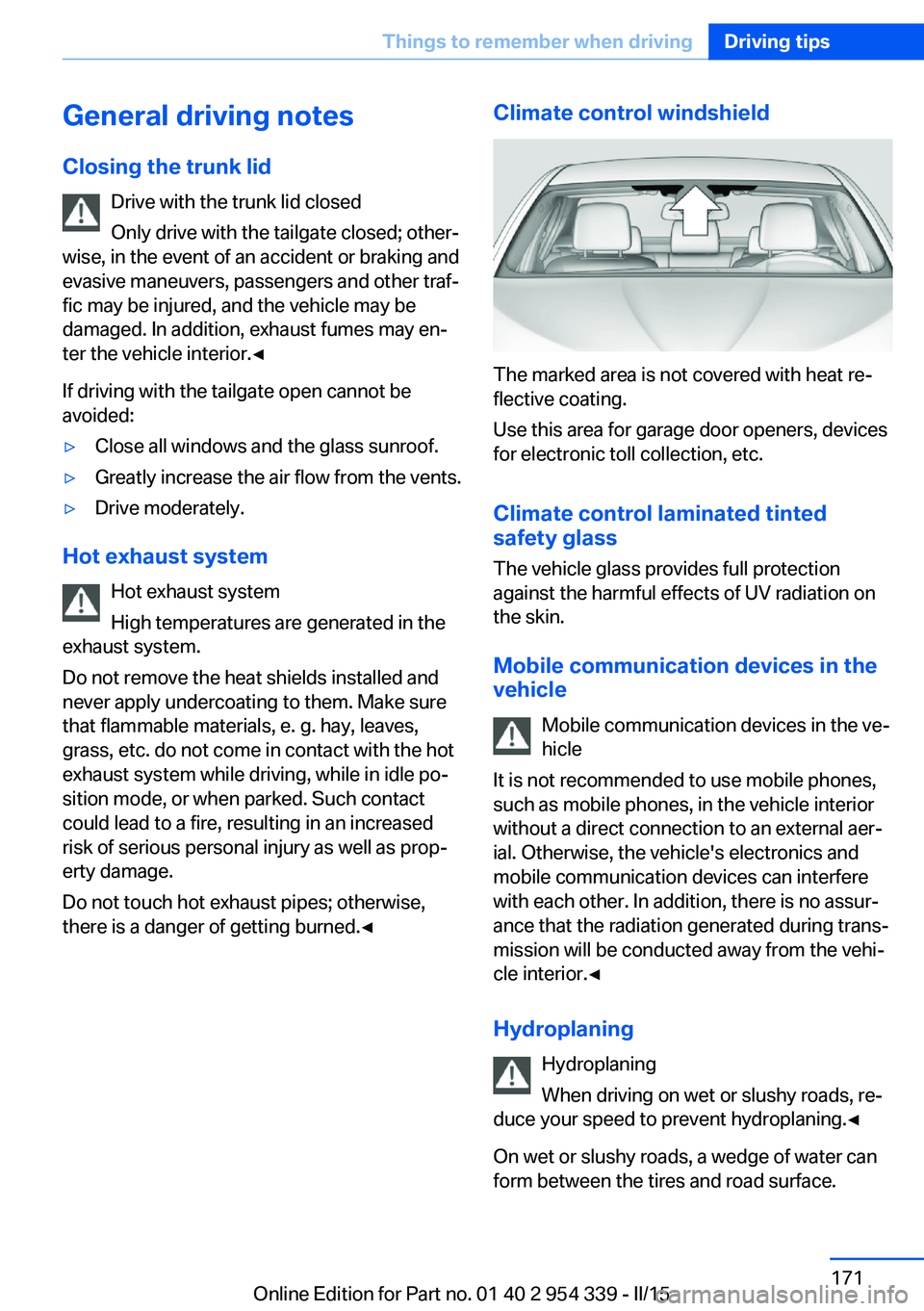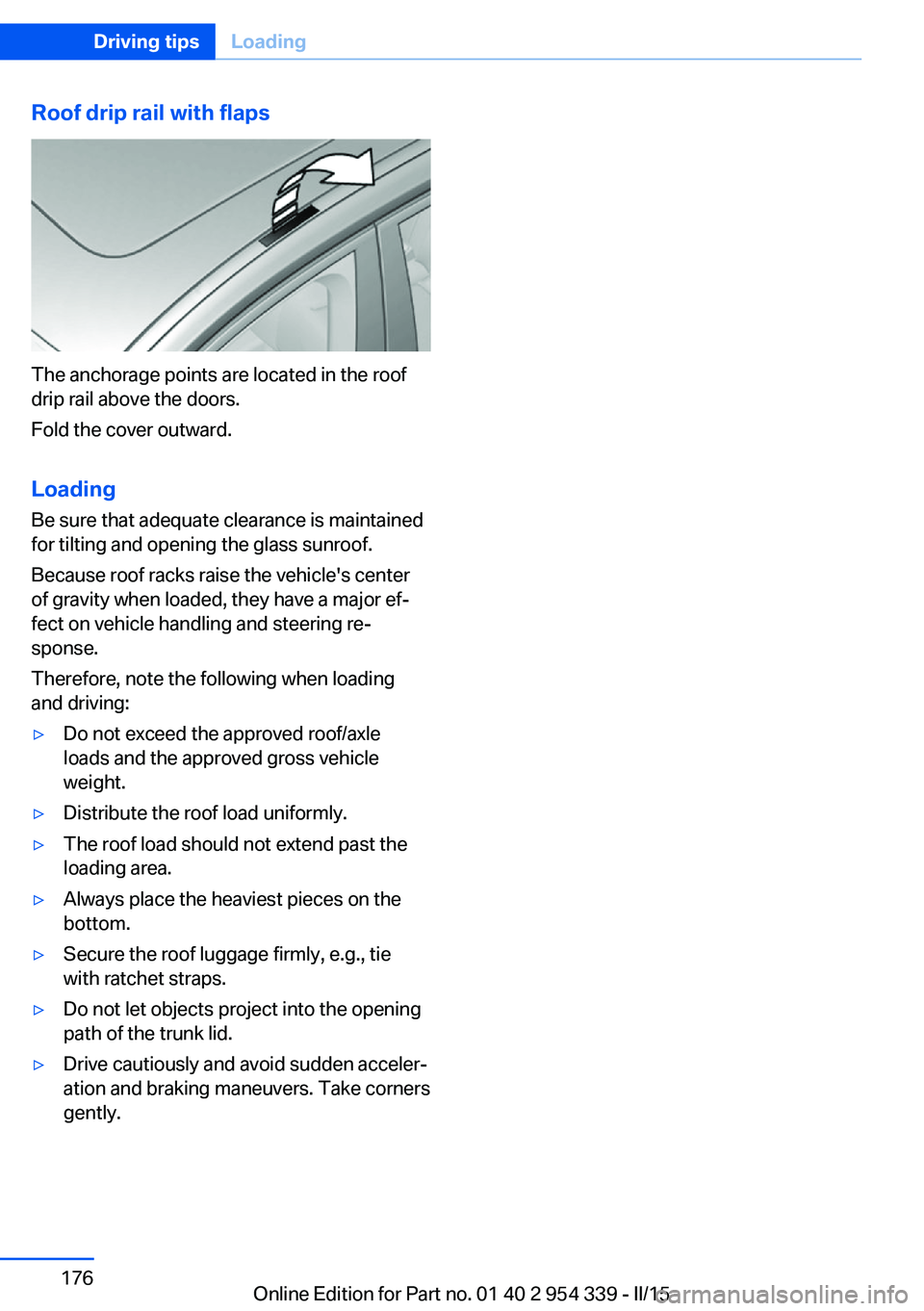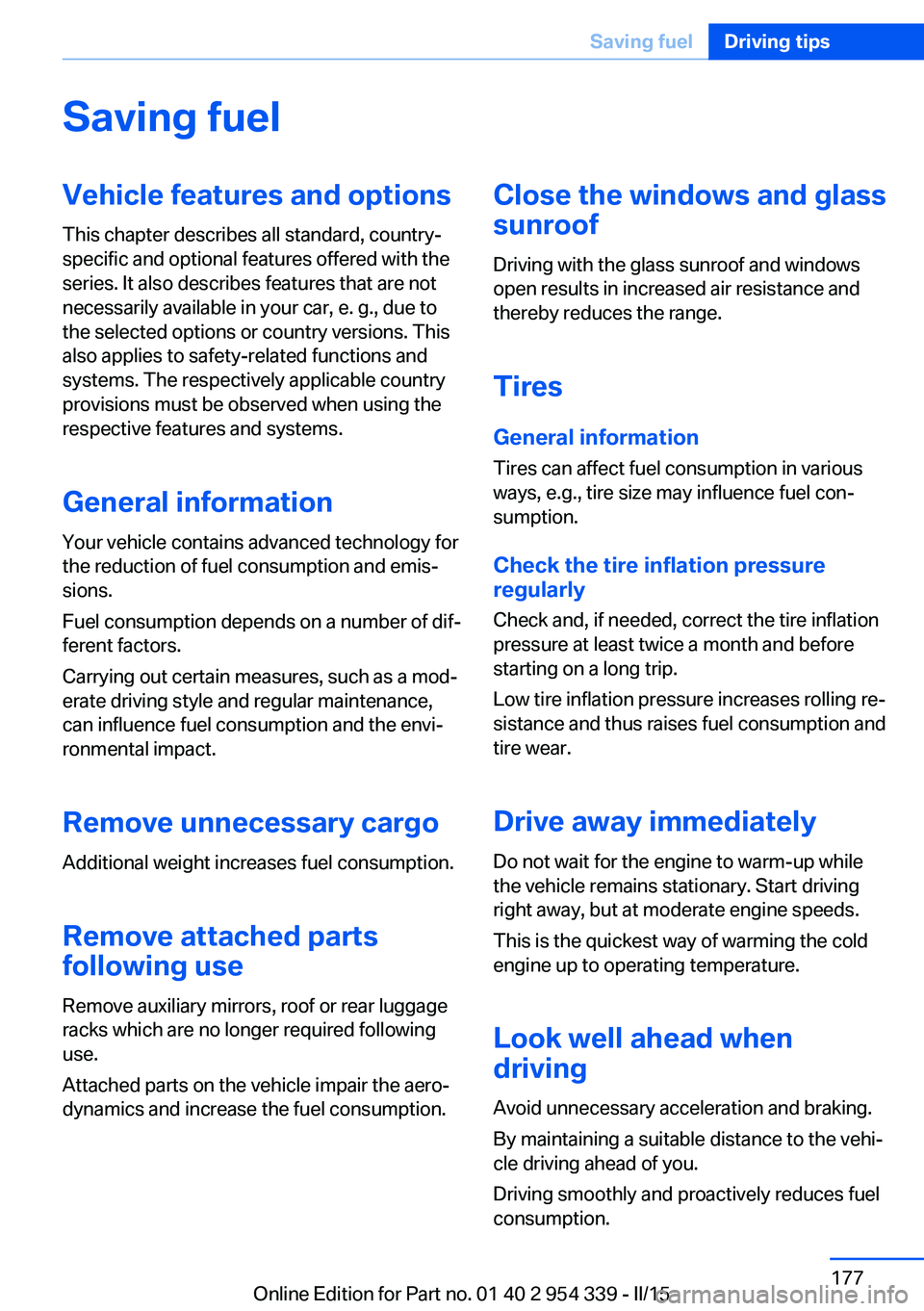2016 BMW M5 SEDAN sunroof
[x] Cancel search: sunroofPage 175 of 239

General driving notes
Closing the trunk lid Drive with the trunk lid closed
Only drive with the tailgate closed; other‐
wise, in the event of an accident or braking and
evasive maneuvers, passengers and other traf‐
fic may be injured, and the vehicle may be
damaged. In addition, exhaust fumes may en‐
ter the vehicle interior.◀
If driving with the tailgate open cannot be avoided:▷Close all windows and the glass sunroof.▷Greatly increase the air flow from the vents.▷Drive moderately.
Hot exhaust system
Hot exhaust system
High temperatures are generated in the
exhaust system.
Do not remove the heat shields installed and
never apply undercoating to them. Make sure
that flammable materials, e. g. hay, leaves,
grass, etc. do not come in contact with the hot
exhaust system while driving, while in idle po‐
sition mode, or when parked. Such contact
could lead to a fire, resulting in an increased
risk of serious personal injury as well as prop‐
erty damage.
Do not touch hot exhaust pipes; otherwise,
there is a danger of getting burned.◀
Climate control windshield
The marked area is not covered with heat re‐
flective coating.
Use this area for garage door openers, devices
for electronic toll collection, etc.
Climate control laminated tinted
safety glass
The vehicle glass provides full protection
against the harmful effects of UV radiation on
the skin.
Mobile communication devices in thevehicle
Mobile communication devices in the ve‐
hicle
It is not recommended to use mobile phones,
such as mobile phones, in the vehicle interior
without a direct connection to an external aer‐
ial. Otherwise, the vehicle's electronics and
mobile communication devices can interfere
with each other. In addition, there is no assur‐
ance that the radiation generated during trans‐
mission will be conducted away from the vehi‐
cle interior.◀
Hydroplaning Hydroplaning
When driving on wet or slushy roads, re‐
duce your speed to prevent hydroplaning.◀
On wet or slushy roads, a wedge of water can
form between the tires and road surface.
Seite 171Things to remember when drivingDriving tips171
Online Edition for Part no. 01 40 2 954 339 - II/15
Page 180 of 239

Roof drip rail with flaps
The anchorage points are located in the roof
drip rail above the doors.
Fold the cover outward.
Loading Be sure that adequate clearance is maintained
for tilting and opening the glass sunroof.
Because roof racks raise the vehicle's center
of gravity when loaded, they have a major ef‐
fect on vehicle handling and steering re‐
sponse.
Therefore, note the following when loading
and driving:
▷Do not exceed the approved roof/axle
loads and the approved gross vehicle
weight.▷Distribute the roof load uniformly.▷The roof load should not extend past the
loading area.▷Always place the heaviest pieces on the
bottom.▷Secure the roof luggage firmly, e.g., tie
with ratchet straps.▷Do not let objects project into the opening
path of the trunk lid.▷Drive cautiously and avoid sudden acceler‐
ation and braking maneuvers. Take corners
gently.Seite 176Driving tipsLoading176
Online Edition for Part no. 01 40 2 954 339 - II/15
Page 181 of 239

Saving fuelVehicle features and optionsThis chapter describes all standard, country-
specific and optional features offered with the
series. It also describes features that are not
necessarily available in your car, e. g., due to
the selected options or country versions. This
also applies to safety-related functions and
systems. The respectively applicable country
provisions must be observed when using the
respective features and systems.
General information Your vehicle contains advanced technology for
the reduction of fuel consumption and emis‐
sions.
Fuel consumption depends on a number of dif‐
ferent factors.
Carrying out certain measures, such as a mod‐
erate driving style and regular maintenance,
can influence fuel consumption and the envi‐
ronmental impact.
Remove unnecessary cargo
Additional weight increases fuel consumption.
Remove attached parts
following use
Remove auxiliary mirrors, roof or rear luggage
racks which are no longer required following use.
Attached parts on the vehicle impair the aero‐
dynamics and increase the fuel consumption.Close the windows and glass
sunroof
Driving with the glass sunroof and windows
open results in increased air resistance and
thereby reduces the range.
Tires
General information Tires can affect fuel consumption in various
ways, e.g., tire size may influence fuel con‐
sumption.
Check the tire inflation pressure
regularly
Check and, if needed, correct the tire inflation
pressure at least twice a month and before
starting on a long trip.
Low tire inflation pressure increases rolling re‐
sistance and thus raises fuel consumption and
tire wear.
Drive away immediately
Do not wait for the engine to warm-up while
the vehicle remains stationary. Start driving
right away, but at moderate engine speeds.
This is the quickest way of warming the cold
engine up to operating temperature.
Look well ahead when
driving
Avoid unnecessary acceleration and braking.
By maintaining a suitable distance to the vehi‐
cle driving ahead of you.
Driving smoothly and proactively reduces fuel
consumption.Seite 177Saving fuelDriving tips177
Online Edition for Part no. 01 40 2 954 339 - II/15
Page 212 of 239

Jacking points for the vehicle jack
The jacking points for the vehicle jack are lo‐
cated at the positions shown.
Vehicle battery Maintenance
The battery is maintenance-free.
The added amount of acid is sufficient for the
service life of the battery.
Further information about the battery can be
obtained from your service center.
Battery replacement Use approved vehicle batteries only
Only use vehicle batteries that have been
approved for your vehicle by the manufacturer;
otherwise, the vehicle could be damaged and
systems or functions may not be fully availa‐
ble.◀
After a battery replacement, have the battery
registered on the vehicle by the service center
to ensure that all comfort features are fully
available and that any Check Control mes‐
sages of these comfort features are no longer
displayed.
Charging the battery
General information Make sure that the battery is always suffi‐
ciently charged to guarantee that the battery
remains usable for its full service life.
The battery may need to be charged in the fol‐
lowing cases:▷When making frequent short-distance
drives.▷If the vehicle is not used for prolonged pe‐
riods, longer than a month.
Hints
Do not connect charging devices to the
12 volt socket in the vehicle
Do not connect battery chargers to the fac‐
tory-installed 12 volt sockets in the vehicle as
this may damage the vehicle battery due to an
increased power consumption.◀
Starting aid terminals
In the vehicle, only charge the battery via the
starting aid terminals, refer to page 212, in the
engine compartment with the engine off.
Power failure
After a temporary power loss, some equipment
needs to be newly initialized or individual set‐
tings updated, e. g.:
▷Seat, mirror, and steering wheel memory:
store the positions again.▷Time: update.▷Date: update.▷Glass sunroof: initialize the system, refer to
page 51.
Disposing of old batteries
Have old batteries disposed of by your
service center or bring them to a recy‐
cling center.
Maintain the battery in an upright position for
transport and storage. Secure the battery so
that it does not tip over during transport.
Seite 208MobilityReplacing components208
Online Edition for Part no. 01 40 2 954 339 - II/15
Page 220 of 239

CareVehicle features and optionsThis chapter describes all standard, country-
specific and optional features offered with the
series. It also describes features that are not
necessarily available in your car, e. g., due to
the selected options or country versions. This
also applies to safety-related functions and
systems. The respectively applicable country
provisions must be observed when using the
respective features and systems.
Car washes General information
Regularly remove foreign objects such as
leaves in the area below the windshield when
the hood is raised.
Wash your vehicle frequently, particularly in
winter. Intense soiling and road salt can dam‐
age the vehicle.
Hints Steam jets or high-pressure washers
When using steam jets or high-pressure
washers, hold them a sufficient distance away
and use a maximum temperature of
140 ℉/60 ℃.
If the vehicle has a glass sunroof, ensure that a
distance of at least 31.5 inches/80 cm is main‐
tained. Holding them too close or using exces‐
sively high pressures or temperatures can
cause damage or preliminary damage that may
then lead to long-term damage.
Follow the user's manual for the high-pressure
washer.◀Cleaning sensors/camera lenses with
high-pressure washers
When using high-pressure washers, do not
spray the sensors and camera lenses on the
outside of the vehicle for long periods and
maintain a distance of at least 12 in/30 cm.◀
Automatic car washes
Hints
Note the following:▷Give preference to cloth car washes or
those that use soft brushes in order to
avoid paint damage.▷Make sure that the wheels and tires are not
damaged by the transport mechanisms.▷Fold in the exterior mirrors; otherwise, they
may be damaged, depending on the width
of the vehicle.▷Deactivate the rain sensor, refer to
page 75, to avoid unintentional wiper acti‐
vation.▷In some cases, an unintentional alarm can
be triggered by the interior motion sensor
of the alarm system. Follow the instruc‐
tions on avoiding an unintentional alarm,
refer to page 48.
Guide rails in car washes
Avoid car washes with guide rails higher
than 4 in/10 cm; otherwise, the vehicle body
could be damaged.◀
Before driving into a car wash In order to ensure that the vehicle can roll in a
car wash, take the following steps:
Manual transmission:
1.Drive into the car wash.2.Shift to neutral.Seite 216MobilityCare216
Online Edition for Part no. 01 40 2 954 339 - II/15
Page 231 of 239

Entering a car wash 216
Equipment, interior 151
Error displays, see Check Control 84
ESP Electronic Stability Pro‐ gram, refer to DSC 129
Exchanging wheels/tires 190
Exhaust system 171
Exterior mirror, automatic dimming feature 61
Exterior mirrors 60
External start 211
External temperature dis‐ play 88
External temperature warn‐ ing 88
Eyes for securing cargo 175
F
Failure message, see Check Control 84
False alarm, refer to Uninten‐ tional alarm 48
Fan, refer to Air flow 145
Filler neck for engine oil 198
Fine wood, care 218
First aid kit 211
Fitting for towing, see Tow fit‐ ting 214
Flat tire, changing wheels 207
Flat Tire Monitor FTM 111
Flat tire, Tire Pressure Moni‐ tor TPM 108
Flat tire, warning lamp 109, 111
Flooding 172
Floor carpet, care 219
Floor mats, care 219
Fold down the rear seat back‐ rest, see Though-loading
system 156
Fold-out position, wiper 76
Foot brake 172
Front airbags 105 Front-end collision warning
with City Braking func‐
tion 113
Front lights 204
front-seat passenger airbags, automatic deactivation 107
Front-seat passenger airbags, indicator lamp 107
FTM Flat Tire Monitor 111
Fuel 184
Fuel consumption, refer to Average fuel consump‐
tion 94
Fuel filler flap 182
Fuel gauge 87
Fuel lid 182
Fuel quality 184
Fuel recommendation 184
Fuel, tank capacity 223
Fuse 209
G
Garage door opener, refer to Universal Integrated Remote
Control 151
Gasoline 184
Gear change 79
Gear shift indicator 91
General driving notes 171
Glare shield 153
Glass sunroof, powered 50
Glove compartment 160
Gross vehicle weight, ap‐ proved 222
Ground clearance 173
H
Handbrake, refer to Parking brake 72
Hand-held transmitter, alter‐ nating code 152
Hazard warning flashers 210
Head airbags 105 Headlight control, auto‐
matic 101
Headlight courtesy delay fea‐ ture 100
Headlight courtesy delay fea‐ ture via remote control 38
Headlight flasher 74
Headlight glass 204
Headlights 204
Headlights, care 217
Headlight washer system 74
Head restraints 53
Head restraints, front 57
Head restraints, rear 58
Head-up Display 97
Head-up Display, care 219
Head-up display, M view 98
Head-up display, standard view 98
Heavy cargo, stowing 175
Height, vehicle 222
High-beam Assistant 102
High beams 74
High beams/low beams, refer to High-beam Assistant 102
Higher speed range 173
Hills 172
Hill start assistant, refer to Drive-off assistant 127
Hints 6
Holder for beverages 162
Homepage 6
Hood 195
Horn 14
Hotel function, trunk lid 42
Hot exhaust system 171
HUD Head-up Display 97
Hydroplaning 171
I Ice warning, see External temperature warning 88
Icy roads, see External tem‐ perature warning 88
Identification marks, tires 187 Seite 227Everything from A to ZReference227
Online Edition for Part no. 01 40 2 954 339 - II/15
Page 234 of 239

PPaint, vehicle 217
Park Distance Control PDC 135
Parked-car ventilation 150
Parked vehicle, condensa‐ tion 173
Parking aid, refer to PDC 135
Parking brake 72
Parking lights 100
Parts and accessories 7
Passenger side mirror, tilting downward 61
Pathway lines, rearview cam‐ era 139
PDC Park Distance Con‐ trol 135
Pedestrian detection, see Night Vision 118
Pedestrian warning with city braking function 115
Personal Profile 35
Personal Profile, exporting profiles 36
Pinch protection system, glass sunroof 51
Pinch protection system, win‐ dows 49
Plastic, care 218
Power failure 208
Power sunroof, glass 50
Power windows 48
Pressure, tire air pres‐ sure 186
Pressure warning FTM, tires 111
Preventing Auto Start Stop 71
Profile, refer to Personal Pro‐ file 35
Programmable memory but‐ tons, iDrive 23
Protective function, glass sunroof 51 Protective function, win‐
dows 49
Push-and-turn switch, refer to Controller 18
R Radiator fluid 200
Radio-operated key, refer to Remote control 34
Radio ready state 68
Radio, see user's manual for Navigation, Entertainment
and Communication
Rain sensor 75
Rear automatic climate con‐ trol 148
Rear lights 206
Rear socket 156
Rearview camera 137
Rearview mirror 60
Rear window defroster 146
Recirculated-air mode 146
Recommended fuel grade 184
Recommended tire brands 190
Refueling 182
Remaining range 89
Remote control/key 34
Remote control, malfunc‐ tion 38
Remote control, univer‐ sal 151
Replacement fuse 209
Replacing parts 203
Replacing wheels/tires 190
Reporting safety defects 9
RES button, see Cruise con‐ trol 133
Reserve warning, refer to Range 89
Reset, Tire Pressure Monitor TPM 109
Residual heat, automatic cli‐ mate control 147 Retaining straps, securing
cargo 175
Retreaded tires 190
Reversing lamp, bulb replace‐ ment 206
Roadside parking lights 101
Roller sunblinds 49
RON recommended fuel grade 184
Roofliner 17
Roof load capacity 222
Roof-mounted luggage rack 175
Rope for tow-starting/ towing 214
Rubber components, care 218
S
Safe braking 172
Safety 7
Safety belt reminder for driv‐ er's seat and front passen‐
ger seat 57
Safety belts 56
Safety belts, care 219
Safety Package, refer to Ac‐ tive Protection 124
Safety switch, windows 49
Safety systems, airbags 105
Saving fuel 177
Screen, refer to Control Dis‐ play 18
Screwdriver, see Onboard ve‐ hicle tool kit 203
Screw thread, refer to Screw thread for tow fitting, screw
thread for tow fitting 215
Sealant 191
Seat belts, refer to Safety belts 56
Seat heating, front 55
Seat heating, rear 55
Seating position for chil‐ dren 64 Seite 230ReferenceEverything from A to Z230
Online Edition for Part no. 01 40 2 954 339 - II/15